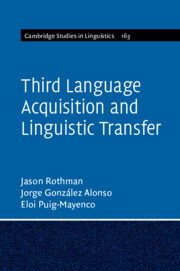Book contents
- Third Language Acquisition and Linguistic Transfer
- Cambridge Studies in Linguistics
- Third Language Acquisition and Linguistic Transfer
- Copyright page
- Dedication
- Contents
- Figures
- Tables
- Acknowledgments
- 1 Setting the Context
- 2 Theoretical Approaches to Sequential Multilingualism
- 3 Multilingual Lexis (Acquisition and Processing) and Phonology
- 4 Transfer in Multilingual Morphosyntax
- 5 A Review of Published Work
- 6 Moving On and Going Forward in L3/Ln Acquisition
- Appendix A
- Appendix B
- Appendix C
- References
- Index
5 - A Review of Published Work
Published online by Cambridge University Press: 07 October 2019
- Third Language Acquisition and Linguistic Transfer
- Cambridge Studies in Linguistics
- Third Language Acquisition and Linguistic Transfer
- Copyright page
- Dedication
- Contents
- Figures
- Tables
- Acknowledgments
- 1 Setting the Context
- 2 Theoretical Approaches to Sequential Multilingualism
- 3 Multilingual Lexis (Acquisition and Processing) and Phonology
- 4 Transfer in Multilingual Morphosyntax
- 5 A Review of Published Work
- 6 Moving On and Going Forward in L3/Ln Acquisition
- Appendix A
- Appendix B
- Appendix C
- References
- Index
Summary
As we saw in great detail in Chapter 4, interest in the L3/Ln acquisition of morphosyntax is thriving. It is not surprising that a substantial amount of research in this emerging field has focused on transfer and/or cross-language effects (CLE) in L3/Ln learning. Examining how previous linguistic experience affects subsequent learning has been a staple topic in nonnative language acquisition for as long as people have been examining L2 acquisition seriously. This curiosity likely springs from both theoretical interests and personal reflection. Even as young lay people – before we were linguists studying this – we recall having some conscious, if not intuitive, feelings that our native languages both propelled and restricted our learning of the additional languages we were studying. Of course, research over many decades – many hundreds, if not thousands of well-designed studies – has shown how far beyond intuitive anecdote the effects that previous linguistic knowledge has on additional language learning go.
Keywords
- Type
- Chapter
- Information
- Third Language Acquisition and Linguistic Transfer , pp. 188 - 246Publisher: Cambridge University PressPrint publication year: 2019

